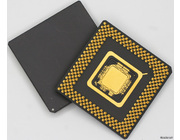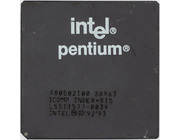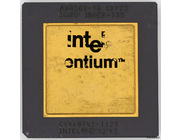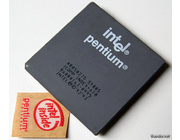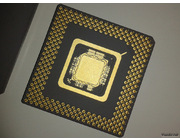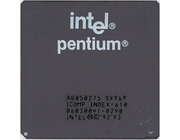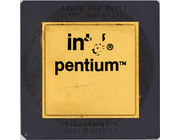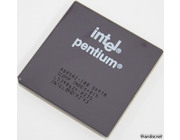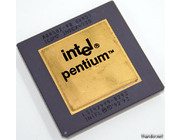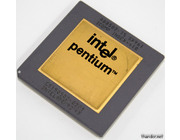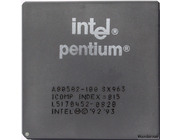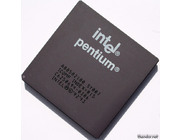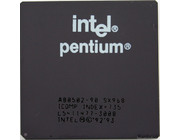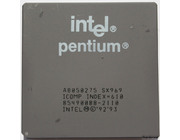A refresh of the P5 operating at 75MHz, 90MHz or 100MHz using 3.3 volt. It is made using a 0.6 µm manufacturing process. The P54C has a 1.5x multiplier in order to let the chip run faster than the motherboard. Motherboards weren't able to run faster, but the chips could easily go above 66MHz.
The die-shrink made it cheaper for Intel to produce the chip and the lower voltage made the Processor run a lot cooler.
An unfinished Pentium P54C CPU! An interesting piece; it's completely blank and doesn't have a 'die' fitted. On the pictures you can see what is located under the 'die' and clearly see the tiny leads that connect the 'die' to the 296 pins on the CPU.
I used the term 'die' a couple of times: a processor like the original Pentium has a package with pins. The package is often made from ceramic. Inside this package is room for a 'die' (the empty spot in the picture of this unfinished Pentium). The term 'die' is derived from 'dicing'; which is cutting the 'die' from a silicon wafer. Inside this silicon 'die' the actual processor core is located.
A thanks note goes out to tsuimusya on a CPU-forum; he was kind enough to share two blank CPU's with me ![]() . > Read more
. > Read more
Identical to this CPU but manufactured in 1996. > Read more
Just like this Pentium 90 but 2 weeks newer. These early Pentium's are also referred to as Pentium goldcap. > Read more
I rarely see these Pentiums in old systems ![]() . Normally they don't have the Intel boxed heatsink and the ones that come by with the boxed heatsink often have a silver sticker on top. This one has blue letters indicating it's an Intel Pentium. > Read more
. Normally they don't have the Intel boxed heatsink and the ones that come by with the boxed heatsink often have a silver sticker on top. This one has blue letters indicating it's an Intel Pentium. > Read more
Dozens of Pentium CPU's exist and this is just one of them. I have more Pentiums running at 100MHz but they are all a tad different because the sSpec number differs. > Read more
As with the Pentium 75's: the 90MHz model was also available with both integrated heat spreader as full ceramic packaging. The older CPU's have a gold colored heat spreader whereas the newer ones are fully ceramic. > Read more
44 weeks older and uses a gold heat spreader for better heat distribution. Besides that it's not much different compared to the newer/regular Pentium 75. > Read more
Same as this Pentium 100 except for the production date, sSpec number and core stepping. This one is older (17th week of 1995) and has core stepping C2. > Read more
In March 1994 this CPU was launched along with the 90MHz model. The 100MHz part was top of the line and ran far ahead on every other x86 CPU. It's a tad faster than the 90MHz because both core and bus frequency are higher. It took Intel exactly one year to release the Pentium 120MHz and two years (March 1996) for AMD to get it's AMD K5 ready. > Read more
Same as the Pentium 75 but then a tad faster due to higher core clock frequency and front side bus. Especially the front side bus has a great impact on this CPU. It clearly jumps ahead on the 75. > Read more
"Pentium done right" in general sense. The core only needs 3,3V instead of 5V like the Pentium 60 or 66. Because of this, and the smaller production size, the heat output is a lot less. Also upgradeability is better as the socket 4 topped out at 66MHz (133MHz for expensive Overdrive chips) where normal socket 7 boards could go up to 133MHz for socket 5 systems.
Unfortunately the Pentium 75 only has a 50MHz front side bus which is a bit too narrow. It's faster brothers, at 90MHz and 100MHz, run noticeably faster because their FSB runs at 60MHz and 66MHz respectively. In the whole Pentium line-up it's clearly visible that 50MHz FSB parts fall behind 60MHz or faster FSB parts. It's no wonder that if you run a Pentium 150 at 3x50MHz FSB it will not be faster than a Pentium 133 (2x66MHz FSB) in overall performance. Try Doom for example; it will run with about 72FPS which is slower than the Pentium 120! Luckily the Pentium 150 uses a 60MHz bus ![]() .
.
Back in the day (1995) our family PC was based on a Pentium 75. A decent PC for it's time however I noticed that some of the games I played mentioned the Pentium 90 as recommended CPU. Looking back with games like Death Rally, Terra Nova, Duke Nukem 3D in SVGA and Fifa Soccer '96 in sVGA: they all run on a Pentium 75 but on a Pentium 90 they are all just that pleasant bit faster. It really shows that the overall performance improves drastically with a higher CPU clock, higher busspeed and higher PCI-bus. The Doom benchmark shows an increase from 53 to 63 FPS on the Pentium 90; that's almost 19% faster! > Read more
